Modeling the Evolution of Mechanical Behavior in Rocks Under Various Water Environments
Abstract
1. Introduction
2. Experimental Data
3. Theoretical Background
3.1. Saturation Effects on Rock Strength
3.2. Effects of Water Pressure on Rock Strength
3.3. Nonlinear Creep Modeling of Rock Under Water Action
4. Numerical Implementation
- (1)
- In step i, the ABAQUS main program provides the following at each integration point: time increment, total stress and its increment, total strain and its increment, pore water pressure, and saturation.
- (2)
- In step i+1, the USDFLD subroutine retrieves saturation and pore water pressure from step i via the GETVRM utility. Depending on saturation (SAT): if SAT < 1, elastic modulus and cohesion are degraded per Equation (4) and Equation (14); if SAT = 1, elastic modulus remains unchanged and cohesion is updated via Equation (15). The saturation is stored as STATEV (1) = SAT, and equivalent stress as STATEV (2) = QTILD for sharing with the CREEP subroutine.
- (3)
- Material parameters (elastic modulus and cohesion) are updated at each integration point based on the current saturation.
- (4)
- The CREEP subroutine reads saturation and equivalent stress from STATEV (1) and STATEV (2), assigns creep model parameters, and computes strain increments (e.g., DECRA (1) and DECRA (5)).
- (5)
- Total strain and stress increments are computed using updated material parameters and creep strain increments.
- (6)
- The main program performs equilibrium iteration using the D-P yield criterion. If convergence is achieved, it proceeds to the next step; otherwise, the step size is reduced and iterated until the i+1th step is completed.
5. Numerical Results
5.1. Model Validation
5.2. Rock Deformation During Water Infiltration Process
5.3. Deformation of a Typical Reservoir Slope Under Water Infiltration
6. Conclusions
- (1)
- A coupled hydro-mechanical creep model was developed and implemented in ABAQUS, capable of simulating the dynamic evolution of rock deformation under variable saturation and pore pressure. Validation against experimental data confirmed its accuracy in capturing saturation-dependent creep behavior.
- (2)
- Numerical simulations revealed that water–creep coupling increases steady-state deformation by over 50% compared to strength degradation alone, with the deformation process progressing through three distinct stages aligned with saturation.
- (3)
- Application to a high arch dam reservoir slope demonstrated that models incorporating both water-weakening and creep effects predict significantly larger deformations than those ignoring these mechanisms, underscoring the importance of coupled hydro-mechanical–creep analysis in slope stability assessment.
Author Contributions
Funding
Data Availability Statement
Acknowledgments
Conflicts of Interest
References
- Ding, S.; Tang, S. Mechanical behavior evolution and failure characteristics of saturated and dry rocks under different water pressure environments. Int. J. Rock Mech. Min. Sci. Géoméch. Abstr. 2024, 178, 105777. [Google Scholar] [CrossRef]
- Wasantha, P.; Ranjith, P.; Permata, G.; Bing, D. Damage evolution and deformation behaviour of dry and saturated sandstones: Insights gleaned from optical measurements. Measurement 2018, 130, 8–17. [Google Scholar] [CrossRef]
- Frenelus, W.; Peng, H. Effects of temperature, water content, hydraulic pressure, stress level and damage on rock creep and the prolonged stability of deep underground structures. Rock Mech. Lett. 2025, 2, 79–89. [Google Scholar] [CrossRef]
- Masoumi, H.; Horne, J.; Timms, W. Establishing Empirical Relationships for the Effects of Water Content on the Mechanical Behavior of Gosford Sandstone. Rock Mech. Rock Eng. 2017, 50, 2235–2242. [Google Scholar] [CrossRef]
- Çelik, M.Y.; Kaçmaz, A.U. The investigation of static and dynamic capillary by water absorption in porous building stones under normal and salty water conditions. Environ. Earth Sci. 2016, 75, 1–19. [Google Scholar] [CrossRef]
- Zhang, Q.; Ran, J.; Fan, X.; Yang, B.; Zhao, P.; Chen, Y.; Huang, P.; Zhang, M.; He, L. Mechanical properties of basalt, tuff and breccia in the Permian system of Sichuan Basin after water absorption–implications for wellbore stability analysis. Acta Geotech. 2022, 18, 2059–2080. [Google Scholar] [CrossRef]
- Kim, E.; Changani, H. Effect of water saturation and loading rate on the mechanical properties of Red and Buff Sandstones. Int. J. Rock Mech. Min. Sci. Géoméch. Abstr. 2016, 88, 23–28. [Google Scholar] [CrossRef]
- Liu, X.; Chen, J.; Liu, B.; Wang, S.; Liu, Q.; Luo, J. Effects of seepage pressure on the mechanical behaviors and microstructure of sandstone. J. Rock Mech. Geotech. Eng. 2024, 16, 2033–2051. [Google Scholar] [CrossRef]
- Wang, H.; Wu, Y.; Qu, X.; Wang, W.; Liu, Y.; Xie, W.-C. Experimental and numerical investigations on failure process and permeability evolution of weathered granite under hydro-mechanical coupling. Int. J. Rock Mech. Min. Sci. Géoméch. Abstr. 2025, 191, 106117. [Google Scholar] [CrossRef]
- Ciantia, M.O.; Castellanza, R.; di Prisco, C. Experimental Study on the Water-Induced Weakening of Calcarenites. Rock Mech. Rock Eng. 2014, 48, 441–461. [Google Scholar] [CrossRef]
- Liu, Y.; Zhang, H.; Qin, Z.; Chen, X.; Liu, W. Energy evolution and deformation features of re-loading creep failure in yellow sandstone after cyclic water intrusion. Int. J. Rock Mech. Min. Sci. Géoméch. Abstr. 2025, 186, 106019. [Google Scholar] [CrossRef]
- Gotzen, L.; Winhausen, L.; Jalali, M.; Khaledi, K.; Amann, F. The long-term strength and creep behavior of fully saturated shaly Opalinus Clay. Eng. Geol. 2025, 348, 107961. [Google Scholar] [CrossRef]
- Yang, C.H.; Wang, Y.Y.; Li, J.G.; Gao, F. Testing study about the effect of different water content on rock creep law. China Coal Soc. 2007, 32, 695–699. (In Chinese) [Google Scholar] [CrossRef]
- Sawatsubashi, M.; Kiyota, T.; Katagiri, T. Effect of initial water content and shear stress on immersion-induced creep deformation and strength characteristics of gravelly mudstone. Soils Found. 2021, 61, 1223–1234. [Google Scholar] [CrossRef]
- Liu, Y.; Zhuang, W.; Gao, C.; Wei, C.; Xue, L.; Yang, Q. Creep parameter inversion and long-term deformation prediction of a near-dam slope considering spatio-temporal deformation data during construction and impoundment period. Eng. Geol. 2025, 351, 108043. [Google Scholar] [CrossRef]
- Nara, Y.; Tanaka, M.; Harui, T. Evaluating long-term strength of rock under changing environments from air to water. Eng. Fract. Mech. 2017, 178, 201–211. [Google Scholar] [CrossRef]
- Hawkins, A.B.; McConnell, B.J. Sensitivity of sandstone strength and deformability to changes in moisture content. Q. J. Eng. Geol. 1992, 25, 115–130. [Google Scholar] [CrossRef]
- Yang, B.Q.; Zhang, L.; Chen, Y.; Chen, J.; Dong, J.; Liu, E. Experimental study on HM coupling effect of weak structural planes for high arch dam abutment. Disaster Prev. 2017, 37, 636–643. (In Chinese) [Google Scholar] [CrossRef]
- Li, T.Y.; Xu, J.; Wang, L.; Ran, J. Experimental research on mechanical characteristics of weak structural plane(zone) under high pore water pressure. Rock Mech. 2012, 31, 3936–3941. (In Chinese) [Google Scholar]
- Yu, C.; Tang, S.; Tang, C.; Duan, D.; Zhang, Y.; Liang, Z.; Ma, K.; Ma, T. The effect of water on the creep behavior of red sandstone. Eng. Geol. 2019, 253, 64–74. [Google Scholar] [CrossRef]
- Erguler, Z.A.; Ulusay, R. Water-induced variations in mechanical properties of clay-bearing rocks. Int. J. Rock Mech. Min. Sci. 2009, 46, 355–370. [Google Scholar] [CrossRef]
- Liu, B.; Zhao, Z.; Chen, S.; Yang, Q. Numerical Modeling on Deformation of Fractured Reservoir Bank Slopes During Impoundment: Case Study of the Xiluodu Dam. Rock Mech. Rock Eng. 2023, 57, 527–543. [Google Scholar] [CrossRef]
- Li, M.; Selvadurai, A.P.S.; Zhou, Z. Observations and Computational Simulation of River Valley Contraction at the Xiluodu Dam, Yunnan, China. Rock Mech. Rock Eng. 2023, 56, 4109–4131. [Google Scholar] [CrossRef]
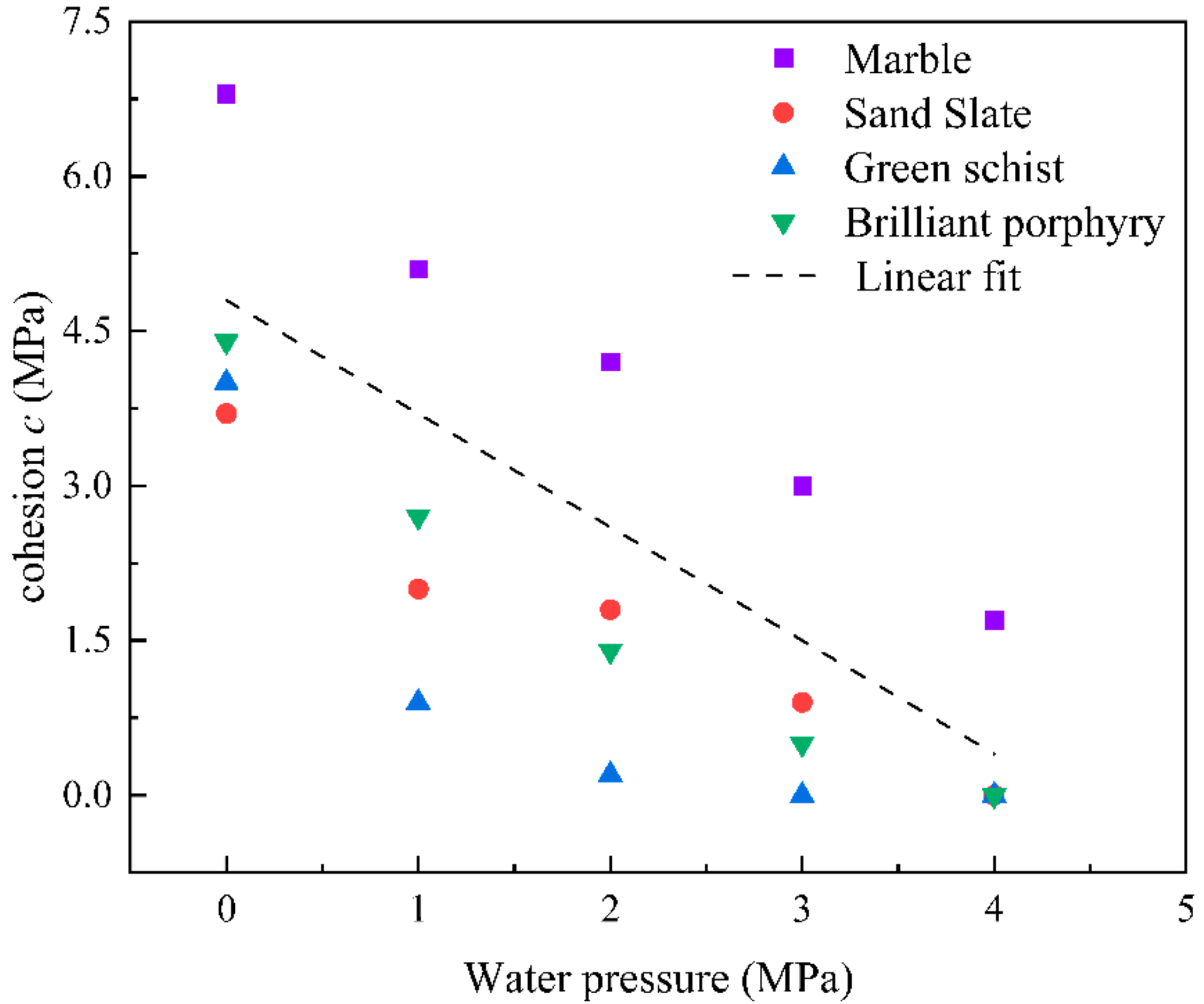
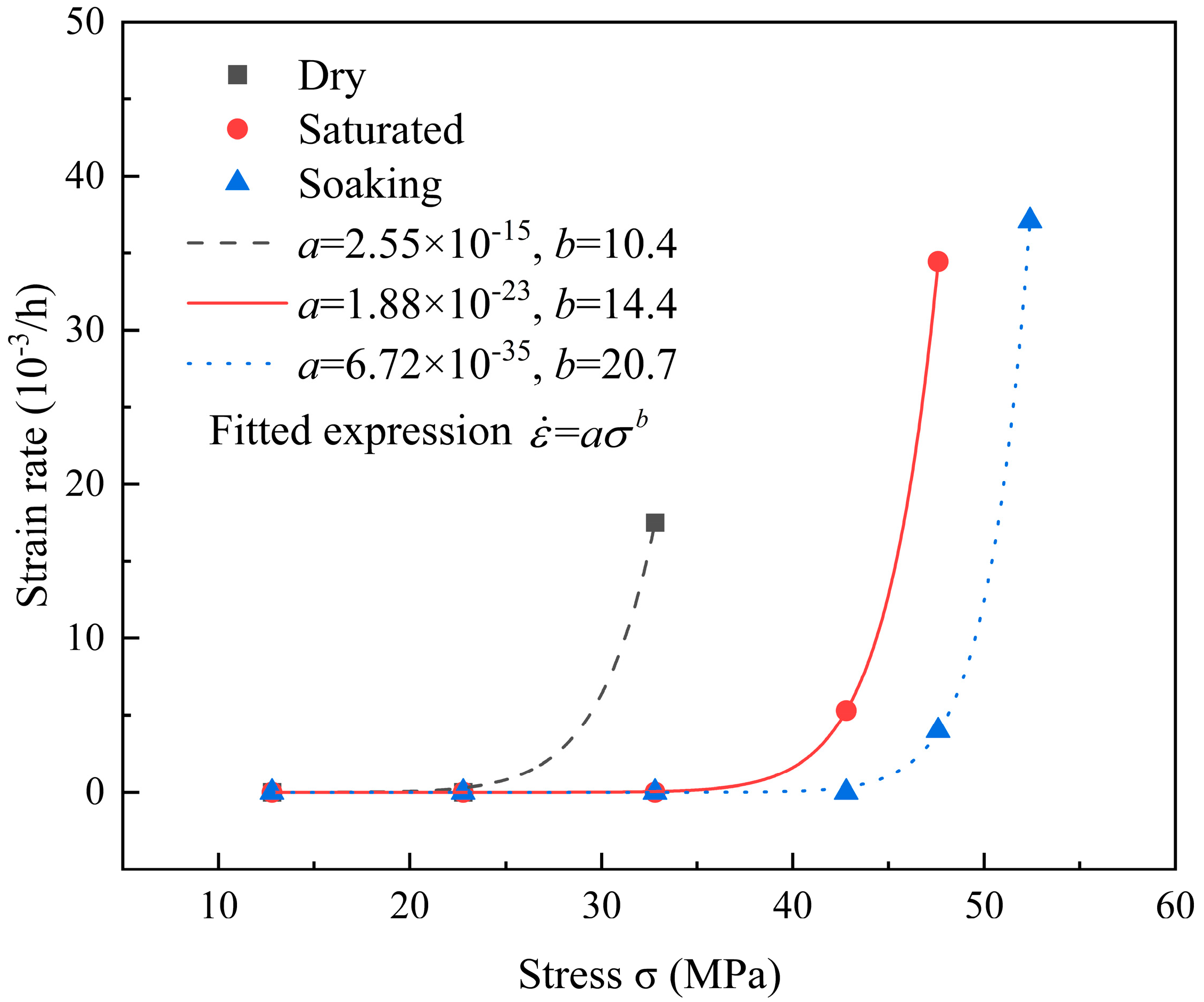
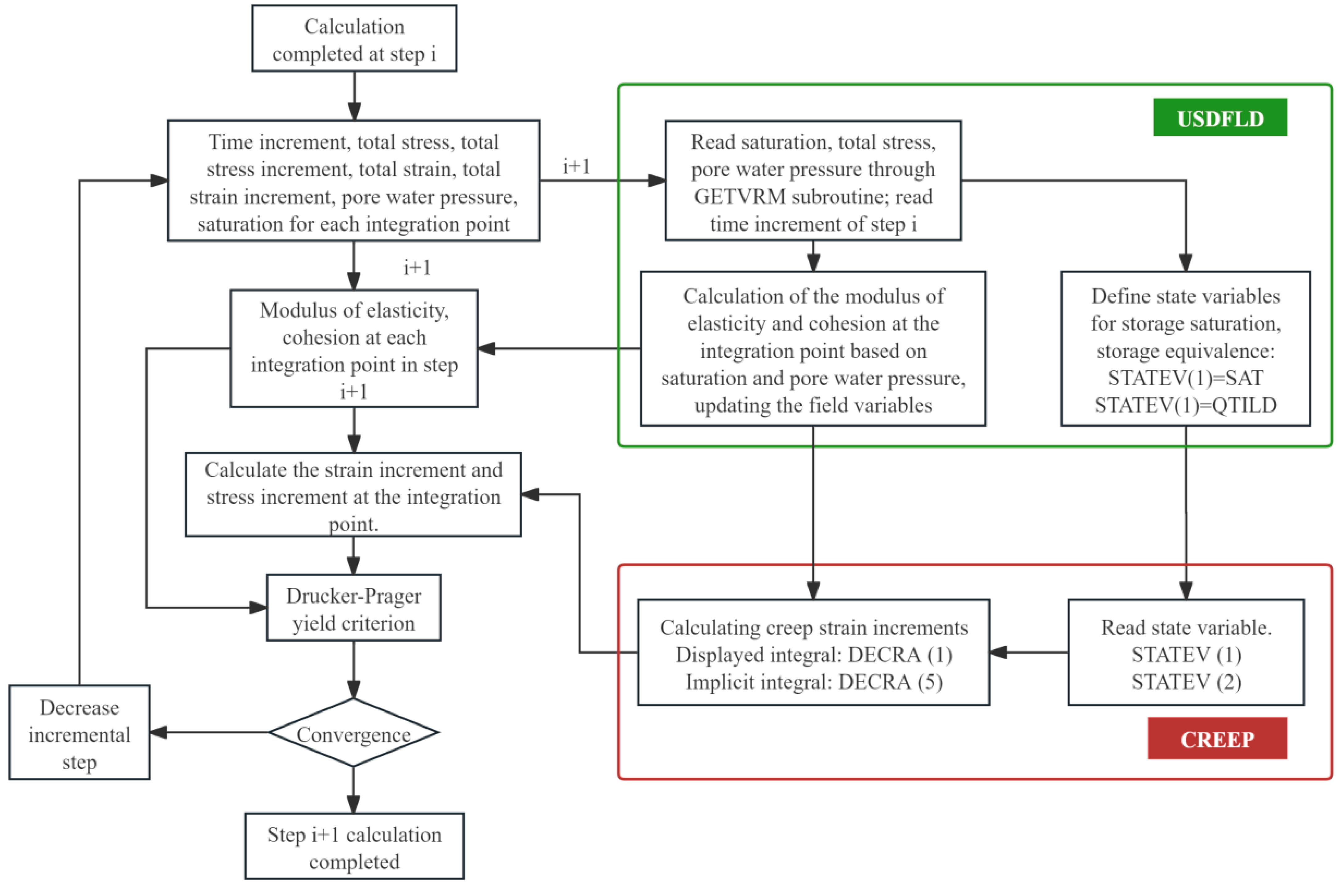
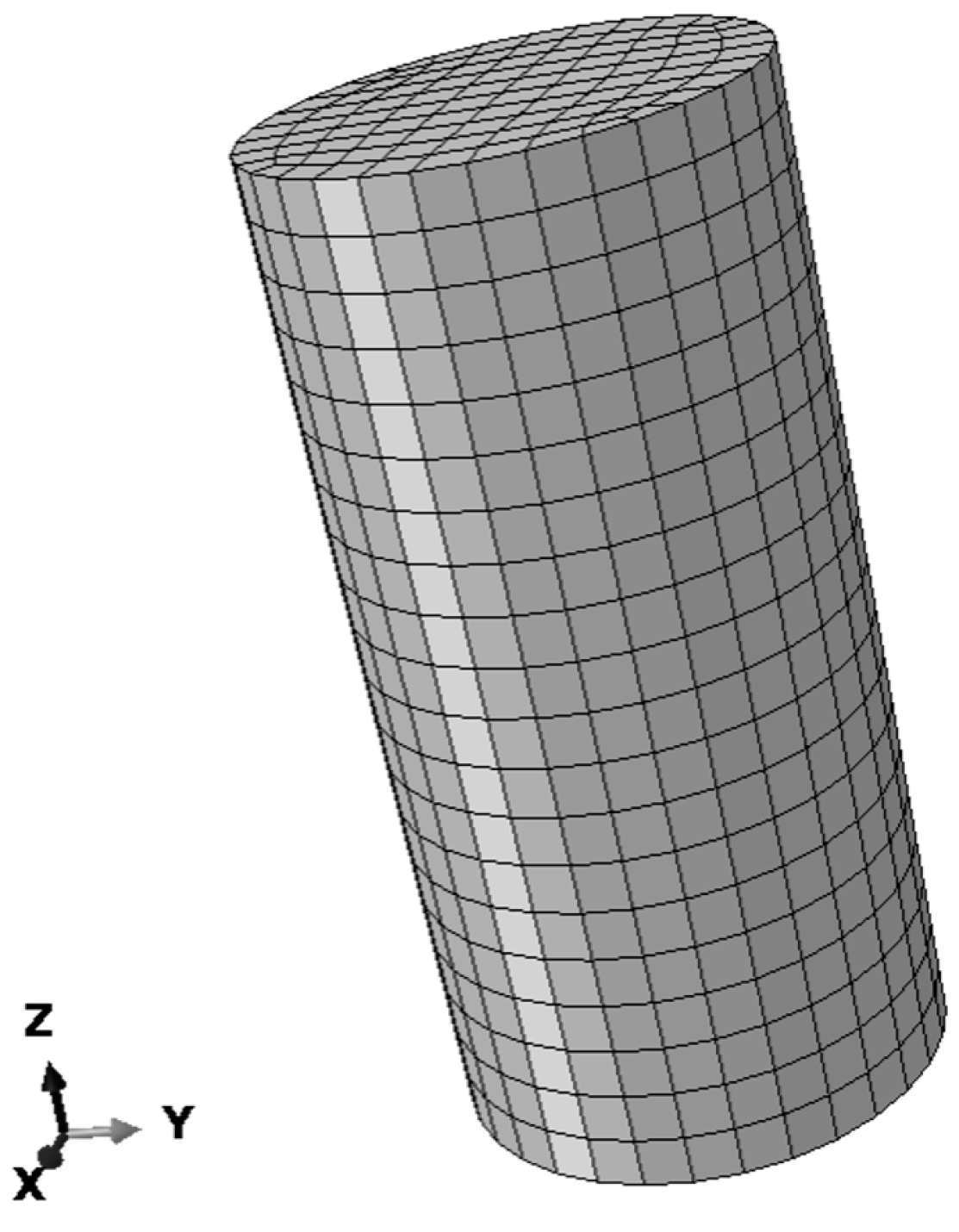
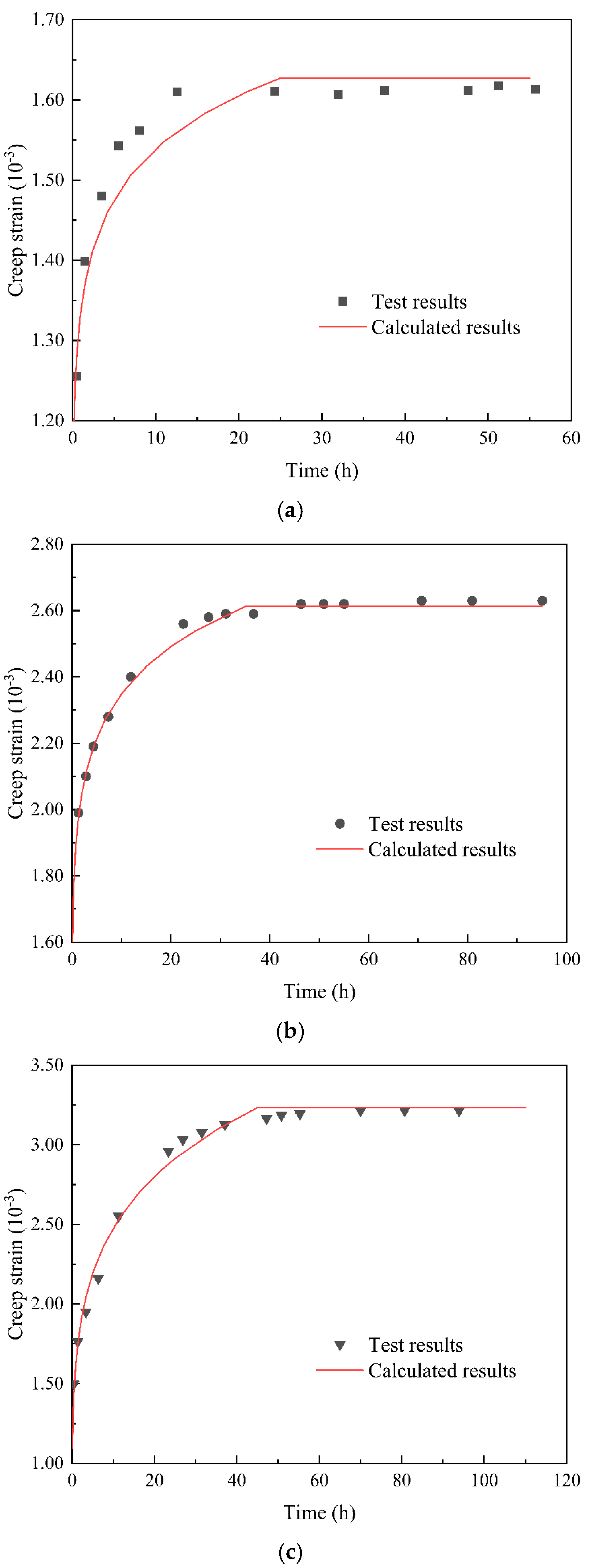
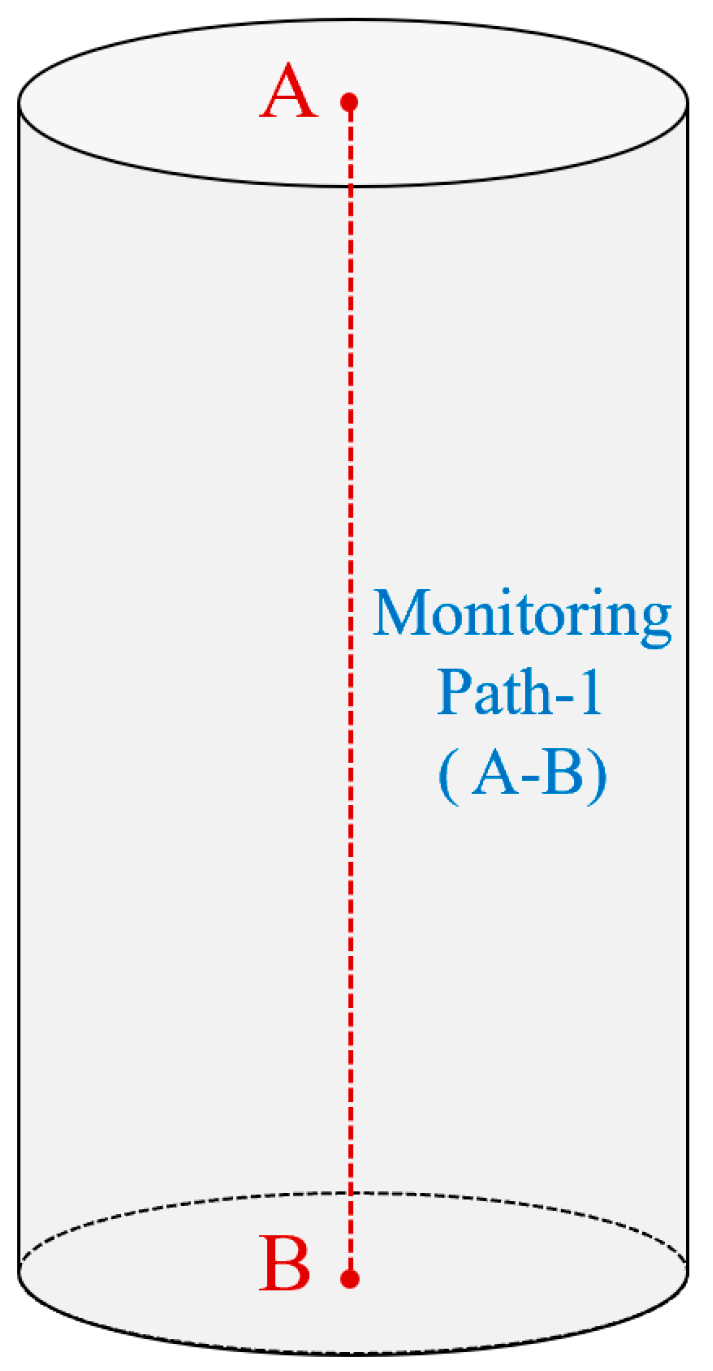
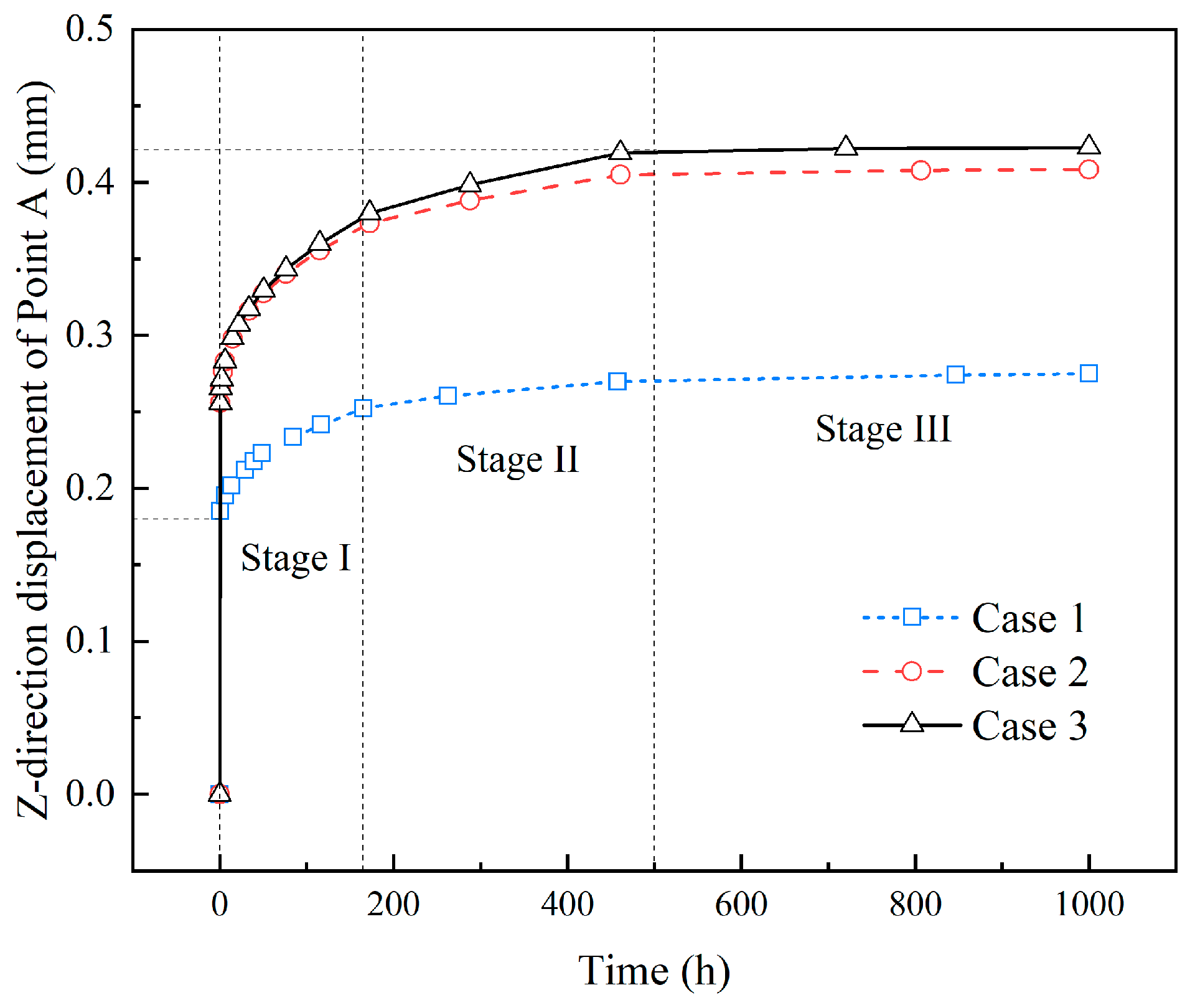
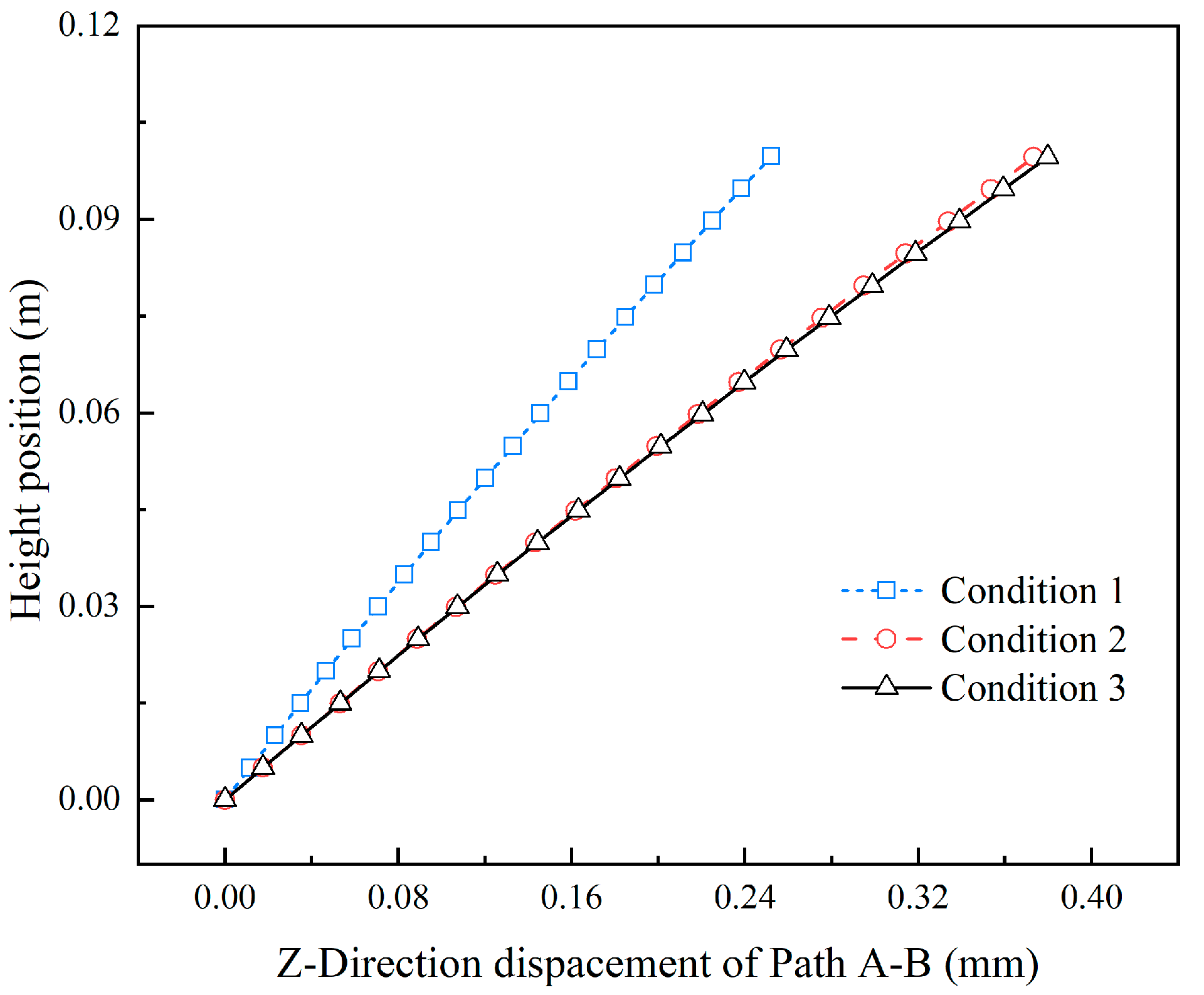
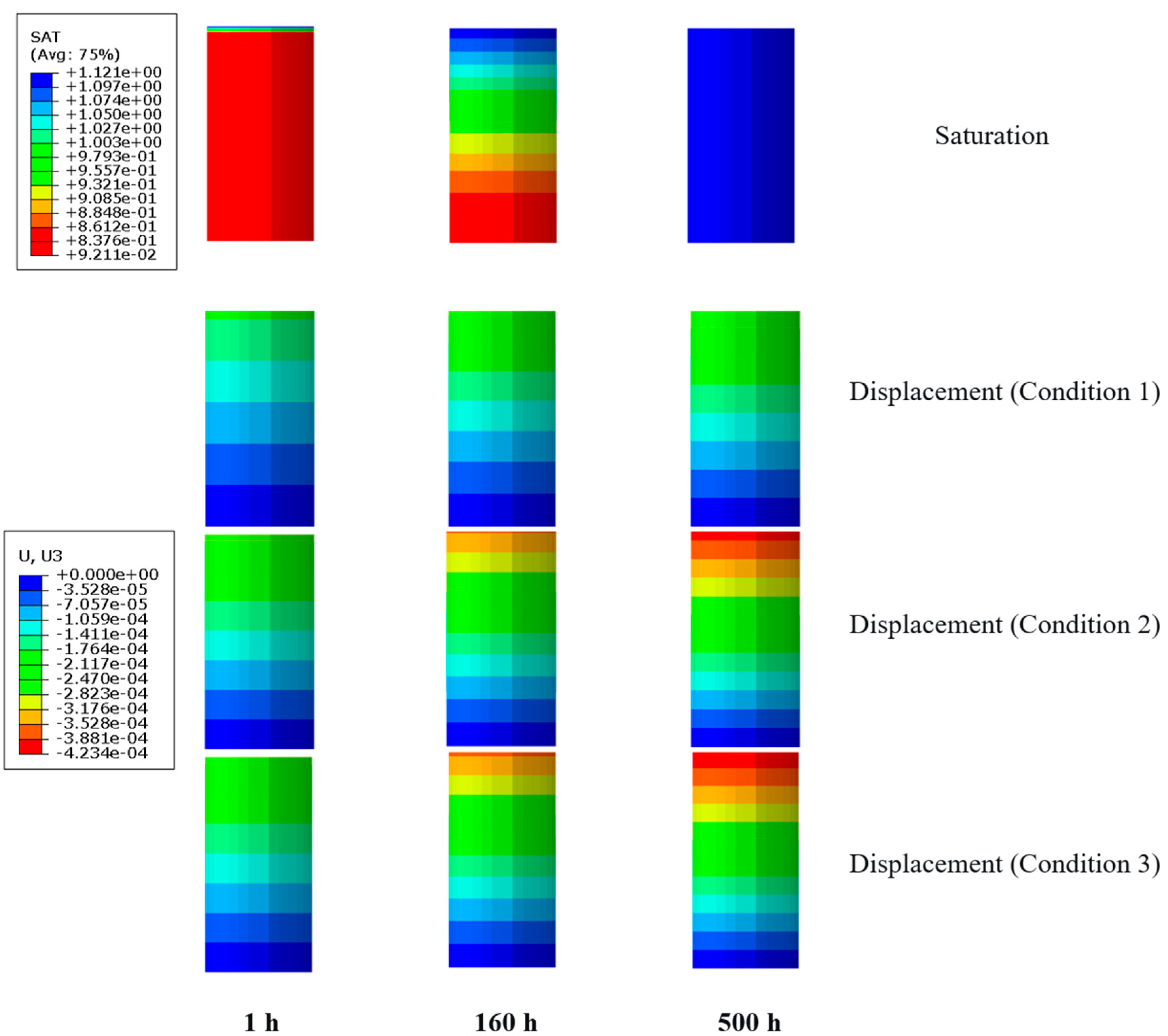
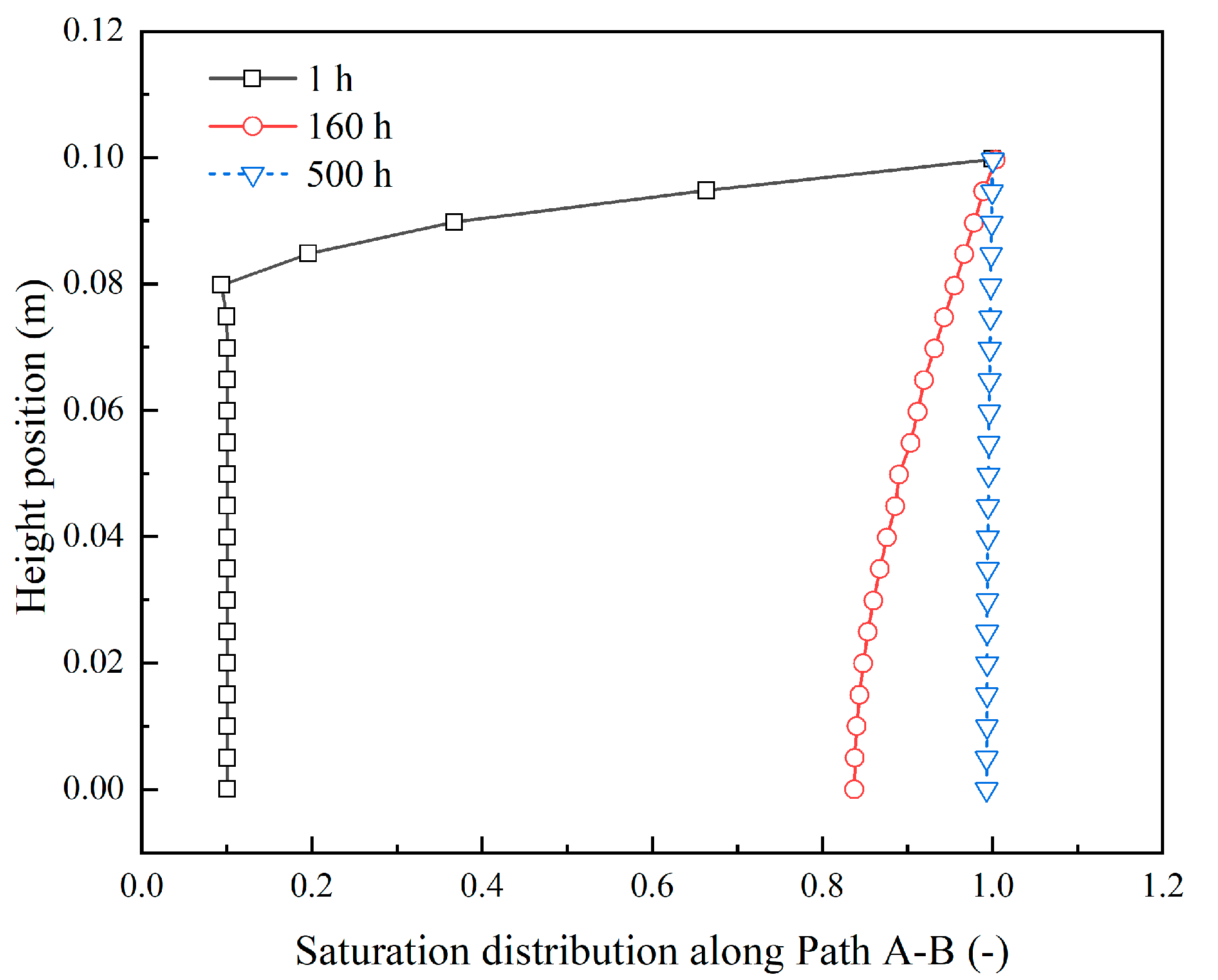
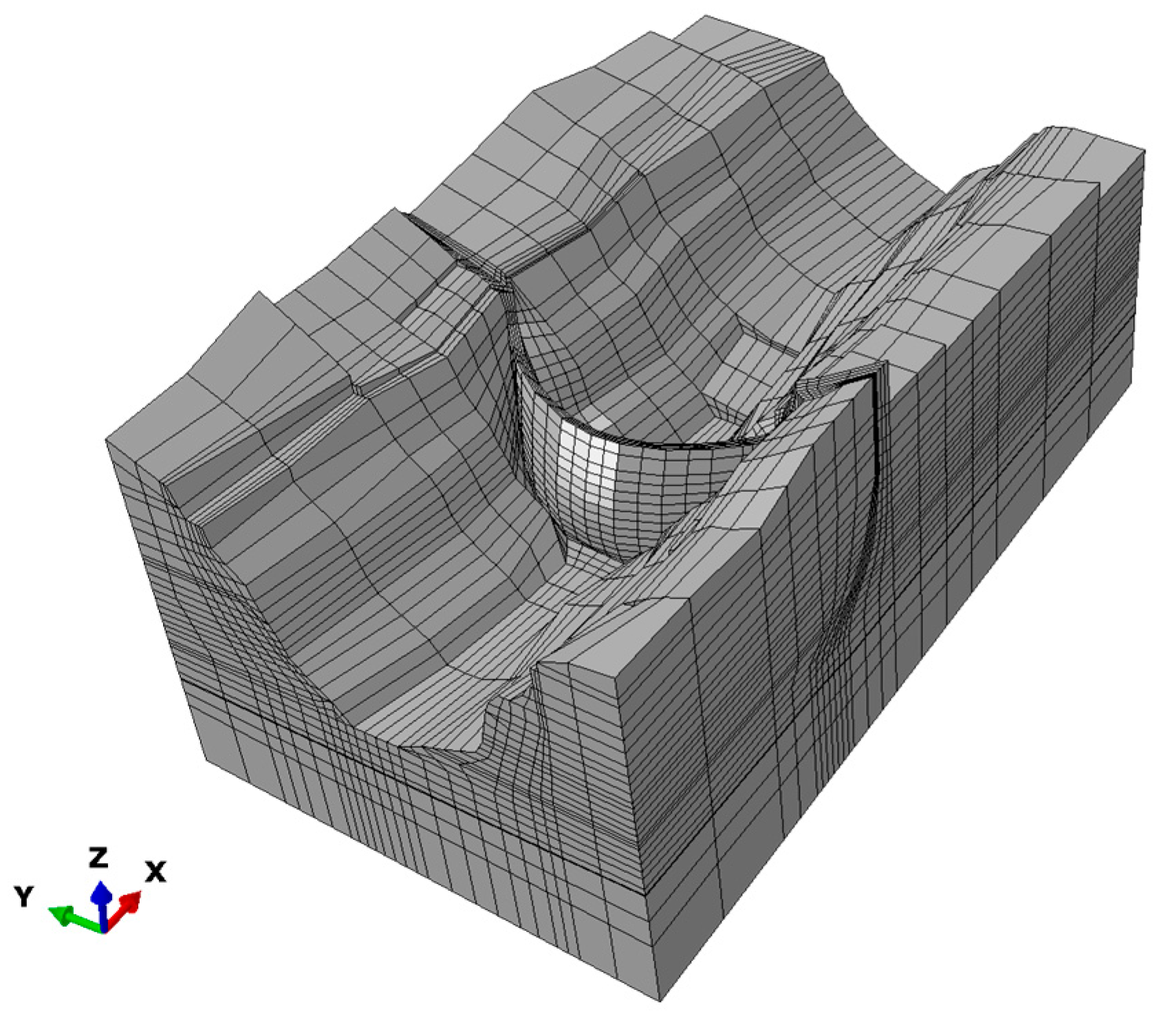
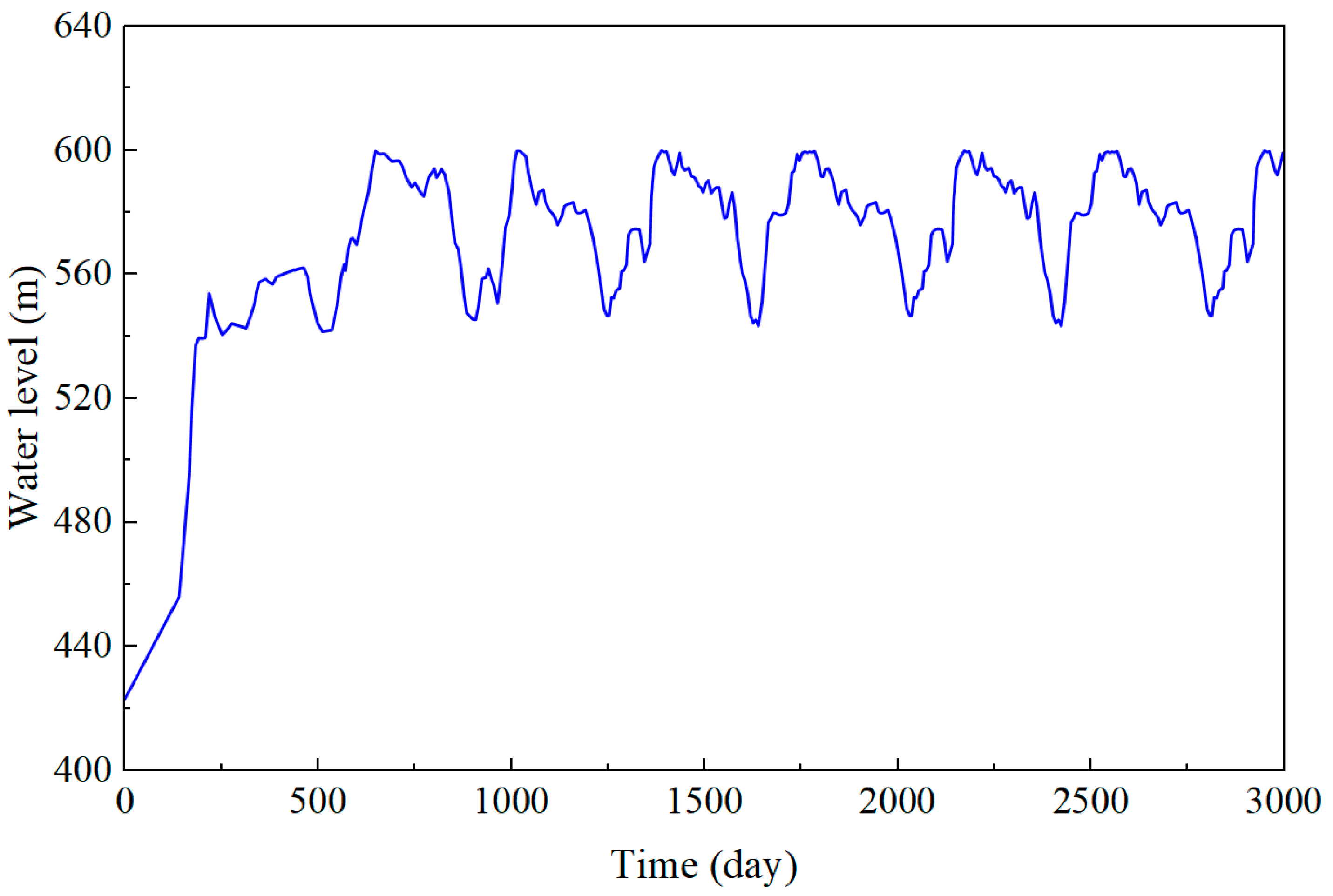
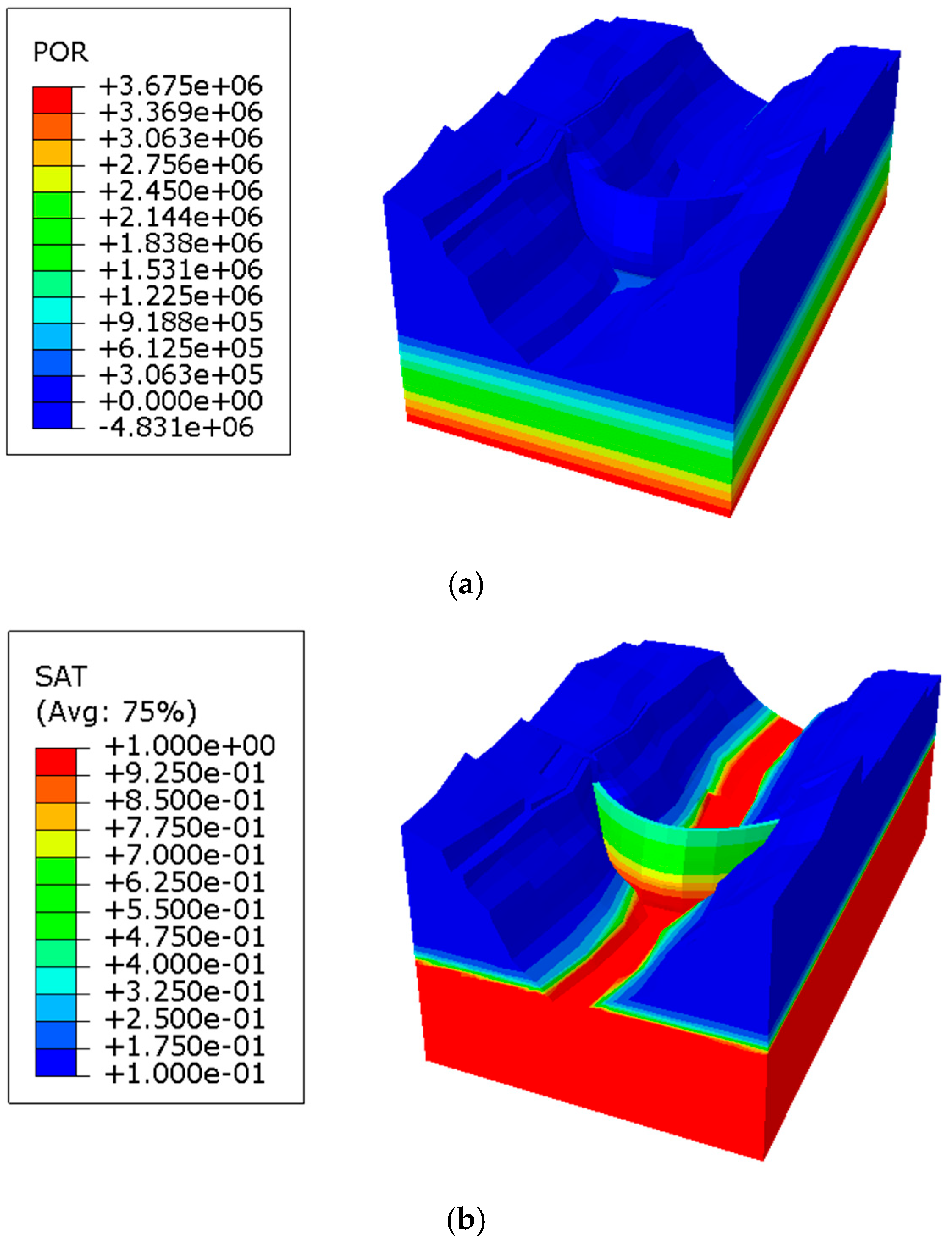
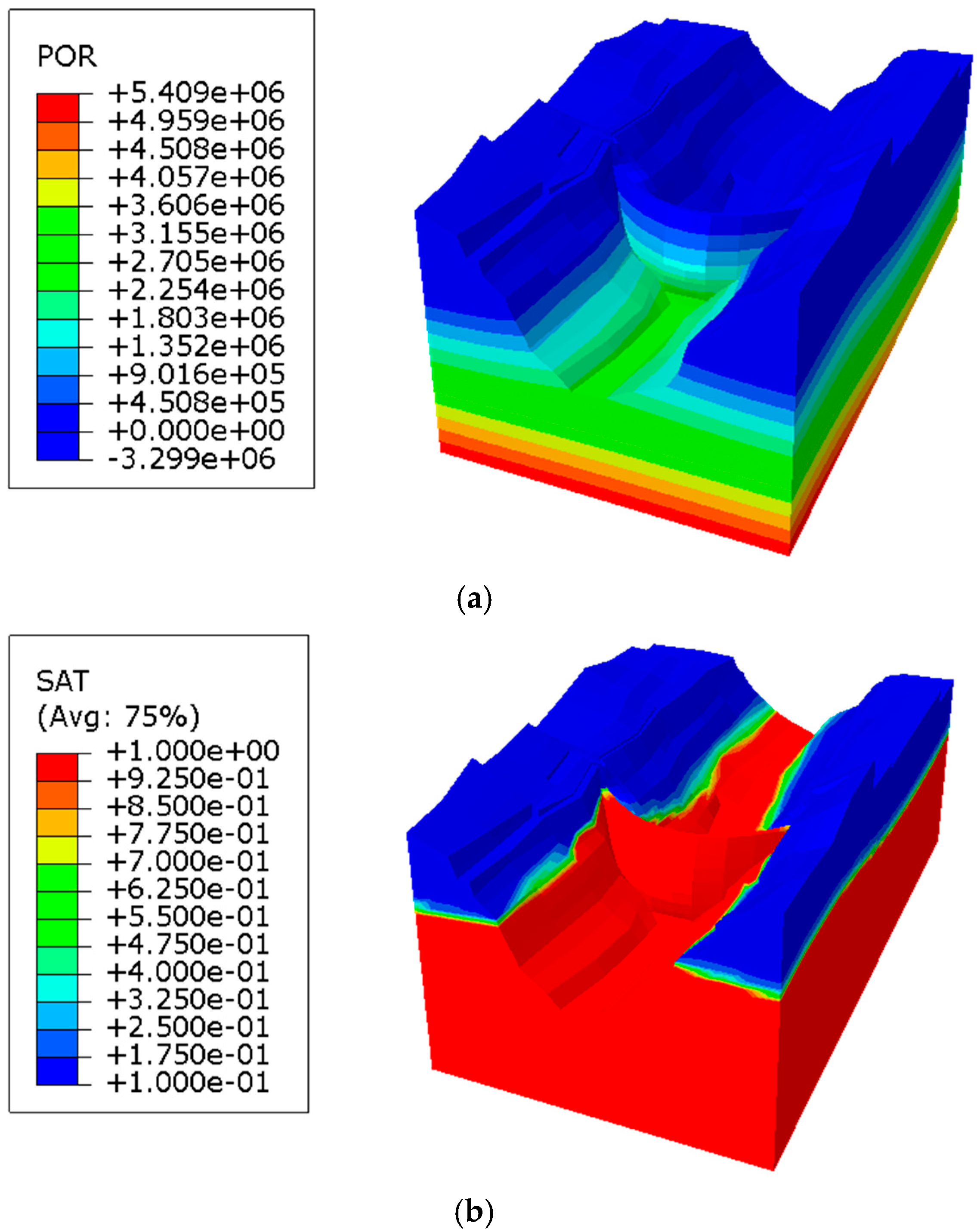
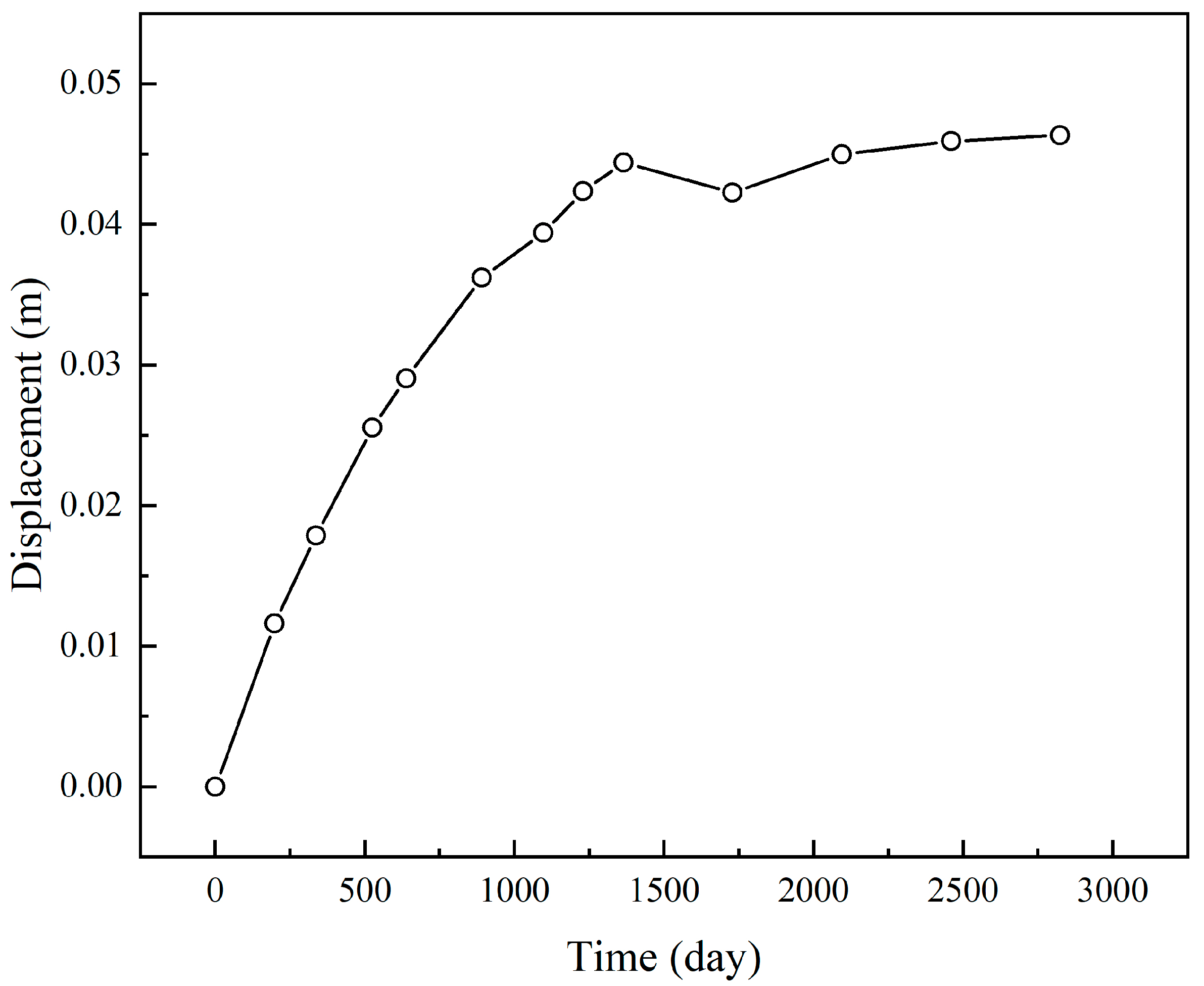
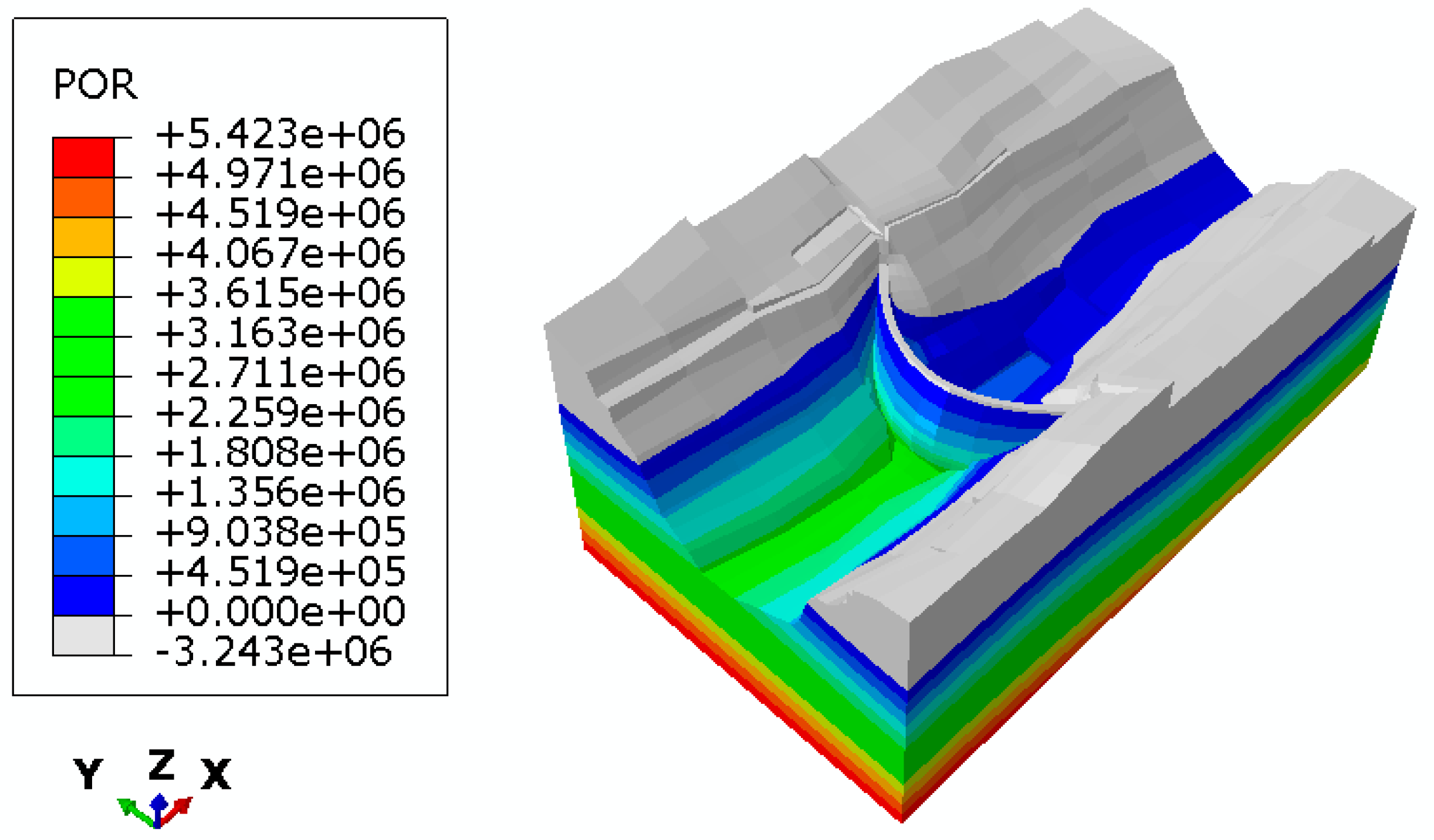
| (MPa) | (-) | (MPa) | (-) | (-) | (-) | (-) | (s) | (s) | (s) | (s) |
|---|---|---|---|---|---|---|---|---|---|---|
| 100 | 2 | 0.1 | 3 | −0.01 | 0.1 | −0.91 | 300 | 500 | −1.3 | 6.2 |
| Material | Elastic Modulus (GPa) | Poisson Ratio | Void Ratio | Density (kg/m3) | Permeability Coefficient (m/s) |
|---|---|---|---|---|---|
| Basalt | 22 | 0.18 | 0.05 | 2700 | 5 × 10−7 |
| Sedimentary Layer | 10 | 0.3 | 0.05 | 2600 | 1 × 10−8 |
| Limestone | 15 | 0.22 | 0.20 | 2500 | 1 × 10−6 |
| Grouted Curtain | 28 | 0.18 | 0.05 | 2750 | 1 × 10−9 |
| Water | - | - | - | 1000 | - |
Disclaimer/Publisher’s Note: The statements, opinions and data contained in all publications are solely those of the individual author(s) and contributor(s) and not of MDPI and/or the editor(s). MDPI and/or the editor(s) disclaim responsibility for any injury to people or property resulting from any ideas, methods, instructions or products referred to in the content. |
© 2025 by the authors. Licensee MDPI, Basel, Switzerland. This article is an open access article distributed under the terms and conditions of the Creative Commons Attribution (CC BY) license (https://creativecommons.org/licenses/by/4.0/).
Share and Cite
Liu, L.; Fu, S.; Jia, X.; Li, X.; Zhang, L. Modeling the Evolution of Mechanical Behavior in Rocks Under Various Water Environments. Water 2025, 17, 2983. https://doi.org/10.3390/w17202983
Liu L, Fu S, Jia X, Li X, Zhang L. Modeling the Evolution of Mechanical Behavior in Rocks Under Various Water Environments. Water. 2025; 17(20):2983. https://doi.org/10.3390/w17202983
Chicago/Turabian StyleLiu, Lixiang, Sai Fu, Xianlin Jia, Xibin Li, and Linfei Zhang. 2025. "Modeling the Evolution of Mechanical Behavior in Rocks Under Various Water Environments" Water 17, no. 20: 2983. https://doi.org/10.3390/w17202983
APA StyleLiu, L., Fu, S., Jia, X., Li, X., & Zhang, L. (2025). Modeling the Evolution of Mechanical Behavior in Rocks Under Various Water Environments. Water, 17(20), 2983. https://doi.org/10.3390/w17202983






